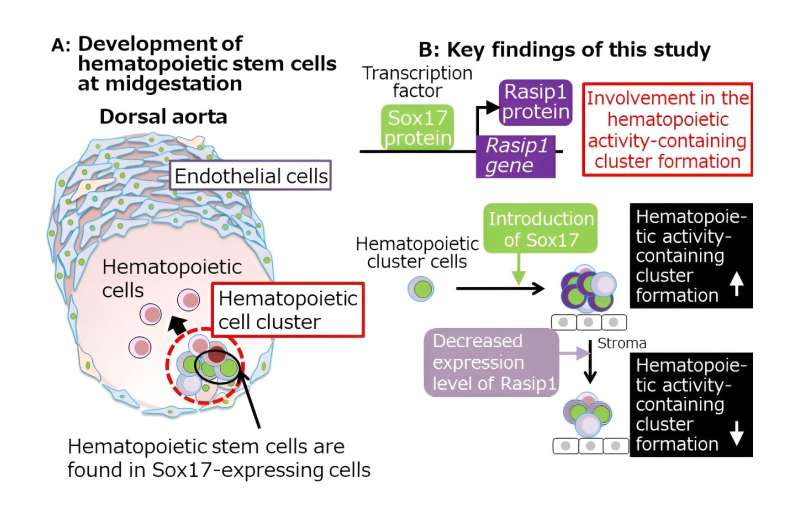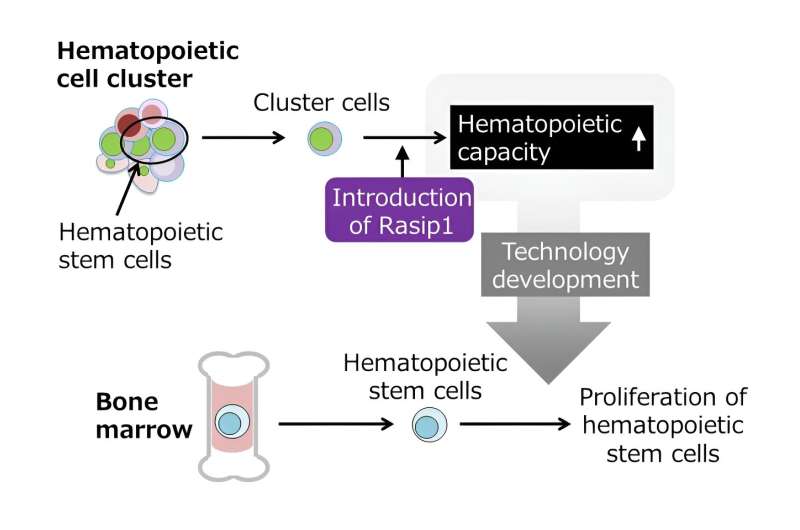This article has been reviewed according to Science X's editorial process and policies. Editors have highlighted the following attributes while ensuring the content's credibility:
fact-checked
trusted source
proofread
The origins of blood: Researchers identify a gene critical to blood production

Blood has long been a symbol of life and health, so it may be surprising that some aspects of blood production (hematopoiesis) remain incompletely understood. One such mystery is the role of a protein called SOX17. Blood cells are generated by hematopoietic stem cells (HSCs), and SOX17 seems to be important to the development of HSCs because SOX17 is expressed where HSCs first develop. What exactly SOX17 does, however, has remained unclear.
Now, a research team at Tokyo Medical and Dental University (TMDU) has discovered just that, revealing that SOX17 targets a gene called Rasip1. To appreciate their research achievement, we first need to know a little more about SOX17 and the origins of blood.
SOX17 is a "transcription factor," a special type of protein that regulates the activities of genes and whether genes are active at any given time. SOX17 is expressed in clusters of cells in a blood vessel called the dorsal aorta; these clusters, called "intra-aortic hematopoietic cell clusters," are where HSCs first develop in mice, around embryonic day 10.5. The researchers aimed to determine SOX17's role in these clusters.
To investigate potential targets of SOX17, the team first carried out RNA-sequencing analysis to see which genes were activated in two very similar populations of cells, one expressing SOX17 and one not.
"One gene that stood out during RNA-sequencing analysis was Rasip1," explains first author Gerel Melig. "This gene is known to be a regulator in vascular cells, which line the blood vessels."

The research team therefore investigated Rasip1 further. They showed that SOX17 binds to the enhancer element of the Rasip1 gene to activate it, and then analyzed the effects of both knocking down and overexpressing the gene. Rasip1 knockdown and subsequent loss of activity resulted in fewer clusters of cells with hematopoietic activity, whereas Rasip1 overexpression increased hematopoietic activity.
"We therefore have proposed a model of early hematopoiesis, in which SOX17 induces the expression of Rasip1, leading to the development of HSCs and associated hematopoietic activity in intra‑aortic hematopoietic cell clusters," says senior author Tetsuya Taga.
This study increases our understanding of the early stages of hematopoiesis. This process, forming all cellular components of blood, occurs not only during embryonic development but also throughout adulthood, producing and replenishing the blood cells in the body. A greater understanding of the mechanisms and molecules involved will enhance our knowledge of the processes underlying disorders and cancers of the blood.
The study is published in the journal Inflammation and Regeneration.
More information: Gerel Melig et al, A Sox17 downstream gene Rasip1 is involved in the hematopoietic activity of intra-aortic hematopoietic clusters in the midgestation mouse embryo, Inflammation and Regeneration (2023). DOI: 10.1186/s41232-023-00292-4



















